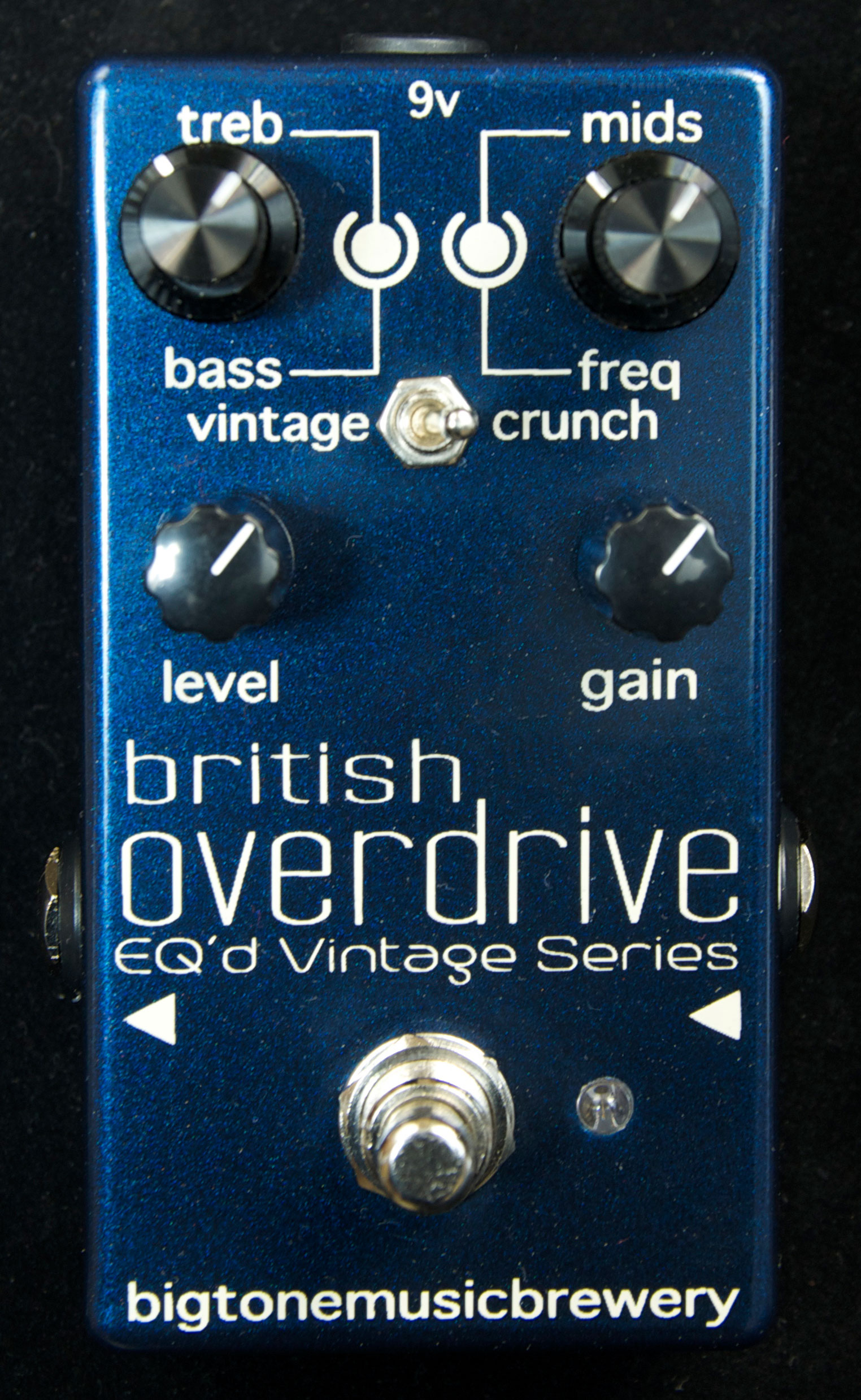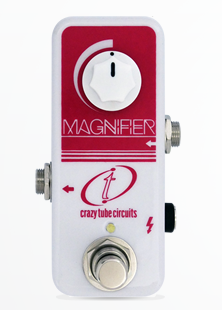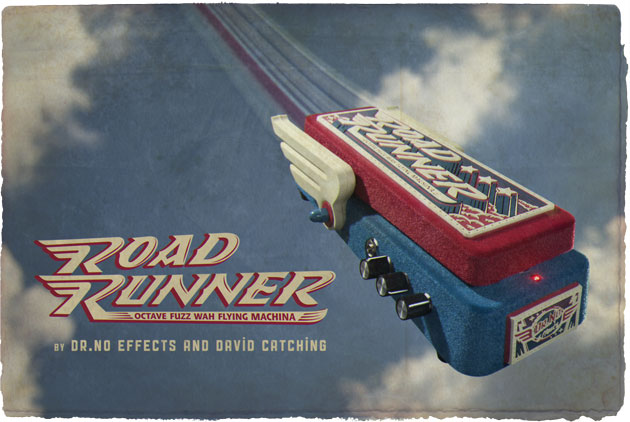 Based in Champaign, Illinois, Analog Outfitters creates cool-looking, boutique-toned amps out of reclaimed materials—sometimes from funky old street signs, but primarily the guts and wood exteriors of less-popular old Hammond organs. The Scanner, however, is an outboard effect built from salvaged Hammond reverb and vibrato sections, and both its long-spring tank and spinning vibrato motor are visible through an acrylic top bookended by subtly rustic woodwork.
Based in Champaign, Illinois, Analog Outfitters creates cool-looking, boutique-toned amps out of reclaimed materials—sometimes from funky old street signs, but primarily the guts and wood exteriors of less-popular old Hammond organs. The Scanner, however, is an outboard effect built from salvaged Hammond reverb and vibrato sections, and both its long-spring tank and spinning vibrato motor are visible through an acrylic top bookended by subtly rustic woodwork.
Though operation is pretty straightforward—two knobs for vibrato, one for reverb, and one for the DI out—the Scanner has a host of features that enhance its usefulness in live and studio applications: 1/4" and XLR inputs (with an instrument-/line-level selector), independent XLR-output volume, a two-button footswitch for activating each effect independently, and a continuous-controller input for remote pedal control of vibrato rate.
Organ Harvesters Extraordinaire
The Scanner’s big vibrato circuit is anything but typical—both in terms of operation and sound. The sonic differences between it and stompbox vibrato/chorus is analogous to the ways tremolo pedals rarely match the buttery trem you get from a nice old tube amp.
The sound was addictive, with a warm, delectably analog feel, and a dimensionality that simply has to be experienced to be fathomed.
According to Analog Outfitters, Hammond organs from 1935 to 1975 were equipped with a unique vibrato section that sent the audio signal to a delay circuit that produced nine phase-shifted copies of the original signal. Those signals were routed to capacitor-like plates mounted inside a “scanner” assembly. Then a rotating armature retrieved the phase-shifted signals from the plates. Analog Outfitters modifies the circuit by using a brushless DC motor they say yields more precise control of vibrato rate.
Ratings
Pros:
Enveloping, mind-bogglingly dimensional and unique vibrato. Flexible studio connectivity.
Cons:
Expensive. Limited reverb control.
Tones:
Ease of Use:
Build/Design:
Value:
Street:
$1,599
Analog Outfitters Scanner
analogoutfitters.com
Telekinetic Ecstasy
From the very first strum, the Scanner moved me in ways I’ve never experienced from a vibrato effect. Signal-chain-wise, I placed the Scanner at the end of my pedalboard, then routed it back to a Radial A/B/Y box that simultaneously sent the signal to Jaguar and Goodsell amps. I also played it straight into a Dr. Z Z-Lux. In both setups—whether I was wearing a Telecaster, an Eastwood or Reverend baritone, or my Schecter Ultra III—the sound was addictive, with a warm, delectably analog feel, and a dimensionality that simply has to be experienced to be fathomed.
You’d be a certifiable idiot to not invest in a continuous controller to toy with the Scanner’s vibrato speed, because the sheer rush you experience when you do is tantamount to a deity stretching forth a finger (or some toes) to spin the world faster or slower and watch in fascination as it goes from one extreme to another. Only in this case, the bewilderment is twofold: Eyes thrill at the sight of metal innards spinning like some sort of supernatural sewing machine, while ears are boggled by the surreally undulating sheets of sound.
At minimum speed, the Scanner serves up ever-so-subtle, but oh-so-warm and syrupy modulation that would shake the resolve of the most ardent anti-chorus-ite. Push the speed treadle to the floor, and the effect isn’t just dizzying—it’s enveloping. Play Kim Thayil’s famously trippy lead from “Black Hole Sun” or Josh Homme’s riffs from “Another Love Song,” and these already-cool sounds blossom into three-dimensional psychedelia that’s truly trippy. The effect is even more disorienting through two or more speaker cabs, as the collection of phased signals reaches your head at slightly different speeds, weaving a cozy sonic blanket that inspires new songs, enlivens old ones, and is, in all honesty, often difficult to bring yourself to disengage.
Drawbars, Ramps, and Reverb
Maybe it was the ghosts of the Scanner’s past lives at work, but though I’ve never found myself yearning to play anything particularly organ like, when I switched my Eastwood to its neck pickup, slowed the Scanner a bit, and plucked complex chords with my thumb and fingers, I found myself lost in a spate of deliciously swampy faux organ parts I never knew lurked in my subconscious.
And then there’s the ramping sound you hear as the vibrato works its way up to or winds its way down from wherever it was: The Scanner will only get there so fast, but there’s something oddly alluring about this lack of control—like you’re at the whim of physics and nature perfectly in tune.
Meanwhile, the Scanner’s reverb is splashy, sexy, and bright—with usable sounds throughout its range and more than enough slosh to please surf fans.
The Verdict
Analog Outfitters’ Scanner has a few quirks. Unity gain (the volume you’d expect if the effect were bypassed) isn’t achieved till you turn the vibrato gain knob to 3 o’clock. Pushing it past that point, however, imbues the tone with a harmonically juicy, very tube-like saturation. Given the price, it’s a bit disappointing that there aren’t mix, dwell, and tone controls for the reverb.
But this is nitpicking, because words can’t do the Scanner justice. Next to it, even excellent vibrato/chorus stomps sound two-dimensional—there’s a “realness” to the effect that could only be rivaled by a rotating speaker. To that point, both in terms of price and transportability, the Scanner is a very compelling middle ground between the magic of a big, bulky Leslie cab and a pedal that’s a pale imitation. That said, I’d get down on my knees and beg for a more affordable version that nixes studio connectivity—and even the reverb—to put the Scanner’s awe-inducing vibrato sounds within reach of incorrigible tone junkies of humbler means.


 Sacrilegious as it may sound to some, not everyone loves the iconic, ubiquitous electric guitar designs of the 1950s. And while vintage guitars that subvert those norms look killer and cut through the visual clutter, they can also be quirky in less-desirable ways: feedback-prone pickups, neck relief like a ski jump, and non-existent tuning stability, to name a few.
Sacrilegious as it may sound to some, not everyone loves the iconic, ubiquitous electric guitar designs of the 1950s. And while vintage guitars that subvert those norms look killer and cut through the visual clutter, they can also be quirky in less-desirable ways: feedback-prone pickups, neck relief like a ski jump, and non-existent tuning stability, to name a few. The new AC10 Custom is a very different amp than the first Vox to bear that name. That AC10 was one of Vox’s very first amps—a more affordable, stripped down little brother to the AC15 that was then revolutionizing the English amplifier landscape.
The new AC10 Custom is a very different amp than the first Vox to bear that name. That AC10 was one of Vox’s very first amps—a more affordable, stripped down little brother to the AC15 that was then revolutionizing the English amplifier landscape. Electronics guru James Demeter has spent more than three decades producing amps and pedals that exemplify his no-frills approach to handcrafted analog gear. Based on his 800-watt VTBP-M-800D bass amp, the new Bass 400 is a petite 400-watt powerhouse that pairs Demeter’s early ’80s VTBP-201 tube preamp with a class-D power amplifier. The idea was to provide a smaller and more affordable alternative to Demeter’s flagship bass amp, with minimal tonal sacrifices.
Half-Power Howler
The Bass 400 comes in two aesthetic flavor options—a caged enclosure (which we received for our test unit) or a tolex-wrapped head. An exceptional handwiring job was revealed when I pulled the amp’s bottom panel off. The preamp’s circuit board looks decidedly old-school next to the modern and precise class-D power-amp board. The preamp’s board is populated with low-noise metal-film resistors and a ceramic socket for the 12AX7 tube. There’s also a little trimmer pot for matching the amp’s output volume with the sensitivity of your bass’ pickups.
Electronics guru James Demeter has spent more than three decades producing amps and pedals that exemplify his no-frills approach to handcrafted analog gear. Based on his 800-watt VTBP-M-800D bass amp, the new Bass 400 is a petite 400-watt powerhouse that pairs Demeter’s early ’80s VTBP-201 tube preamp with a class-D power amplifier. The idea was to provide a smaller and more affordable alternative to Demeter’s flagship bass amp, with minimal tonal sacrifices.
Half-Power Howler
The Bass 400 comes in two aesthetic flavor options—a caged enclosure (which we received for our test unit) or a tolex-wrapped head. An exceptional handwiring job was revealed when I pulled the amp’s bottom panel off. The preamp’s circuit board looks decidedly old-school next to the modern and precise class-D power-amp board. The preamp’s board is populated with low-noise metal-film resistors and a ceramic socket for the 12AX7 tube. There’s also a little trimmer pot for matching the amp’s output volume with the sensitivity of your bass’ pickups.


 If you don’t yet know the Big Tone Music Brewery name, you probably know the people behind the company. It’s a sister of Build Your Own Clone (B.Y.O.C.), the little-stompbox-kit-company-that-could whose pedals often top best-alternative lists for everything from Big Muffs to Boss Vibratos.
If you don’t yet know the Big Tone Music Brewery name, you probably know the people behind the company. It’s a sister of Build Your Own Clone (B.Y.O.C.), the little-stompbox-kit-company-that-could whose pedals often top best-alternative lists for everything from Big Muffs to Boss Vibratos. Buffer/preamp pedals are typically deployed to reinvigorate a signal sapped of its treble vitality by lots of circuit capacitance (e.g., tons of pedals or long cables). But they’re useful for far more than that—especially if you prefer tube amps dialed to the verge of breakup.
Buffer/preamp pedals are typically deployed to reinvigorate a signal sapped of its treble vitality by lots of circuit capacitance (e.g., tons of pedals or long cables). But they’re useful for far more than that—especially if you prefer tube amps dialed to the verge of breakup. Ever since Maestro unleashed the FZ-1 fuzz in 1962, the quest to destroy clean guitar tones has remained more or less relentless. In recent years, builders like Death By Audio and ZVex pushed fuzz to extremes. Then came the rise of bitcrushers—the rabid lovechildren of a Tone Bender and a Nintendo 64 sound card—and the movement to eschew pristine tones in favor of mangled, unpredictable squawks marched on.
Ever since Maestro unleashed the FZ-1 fuzz in 1962, the quest to destroy clean guitar tones has remained more or less relentless. In recent years, builders like Death By Audio and ZVex pushed fuzz to extremes. Then came the rise of bitcrushers—the rabid lovechildren of a Tone Bender and a Nintendo 64 sound card—and the movement to eschew pristine tones in favor of mangled, unpredictable squawks marched on. Hot on the heels of their first offering for bassists with the Factotum, New Zealand’s Red Witch has followed up in big fashion with the all-analog Zeus suboctave/silicon-fuzz pedal. Like the Greek god it shares its name with, this box is powerful, easily angered, and able to unleash a thunderstorm at will.
Hot on the heels of their first offering for bassists with the Factotum, New Zealand’s Red Witch has followed up in big fashion with the all-analog Zeus suboctave/silicon-fuzz pedal. Like the Greek god it shares its name with, this box is powerful, easily angered, and able to unleash a thunderstorm at will. The Jordan Fuzztite is Mahoney Guitar Gear's take on the rare late-’60s Mosrite Fuzzrite—specifically, the silicon-based versions made after the first 250 germanium units. Like the original, it has volume and depth controls, while an added toggle boosts volume and frequency girth in its up position by removing a 22k filter resistor from the circuit.
The Jordan Fuzztite is Mahoney Guitar Gear's take on the rare late-’60s Mosrite Fuzzrite—specifically, the silicon-based versions made after the first 250 germanium units. Like the original, it has volume and depth controls, while an added toggle boosts volume and frequency girth in its up position by removing a 22k filter resistor from the circuit. Based in Champaign, Illinois, Analog Outfitters creates cool-looking, boutique-toned amps out of reclaimed materials—sometimes from funky old street signs, but primarily the guts and wood exteriors of less-popular old Hammond organs. The Scanner, however, is an outboard effect built from salvaged Hammond reverb and vibrato sections, and both its long-spring tank and spinning vibrato motor are visible through an acrylic top bookended by subtly rustic woodwork.
Based in Champaign, Illinois, Analog Outfitters creates cool-looking, boutique-toned amps out of reclaimed materials—sometimes from funky old street signs, but primarily the guts and wood exteriors of less-popular old Hammond organs. The Scanner, however, is an outboard effect built from salvaged Hammond reverb and vibrato sections, and both its long-spring tank and spinning vibrato motor are visible through an acrylic top bookended by subtly rustic woodwork.





 Stevensville, MD (November 18, 2015) -- PRS Guitars recently added two new baritone guitars, the new SE 277 Semi Hollow Soapbar and the SE 277, to its bevy of more affordable guitar model options. Tuned B to B, two and a half steps below standard, the two new baritones offer a taut muscular low end, with powerful aggressive tones and flexibility of going from chimey clean, to warm depth, to articulate tonal hostility.
Stevensville, MD (November 18, 2015) -- PRS Guitars recently added two new baritone guitars, the new SE 277 Semi Hollow Soapbar and the SE 277, to its bevy of more affordable guitar model options. Tuned B to B, two and a half steps below standard, the two new baritones offer a taut muscular low end, with powerful aggressive tones and flexibility of going from chimey clean, to warm depth, to articulate tonal hostility.